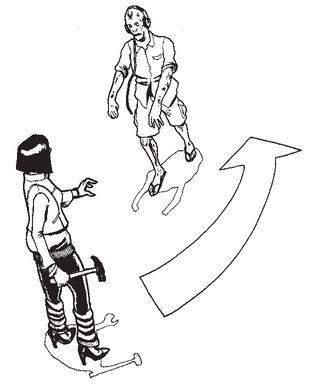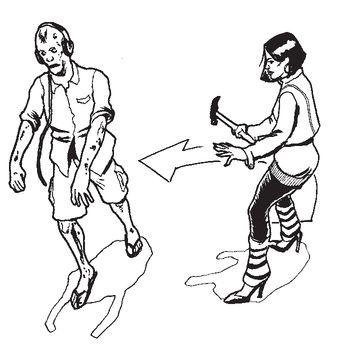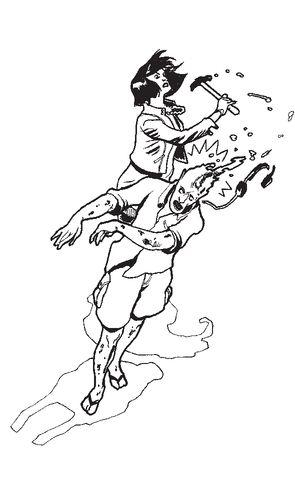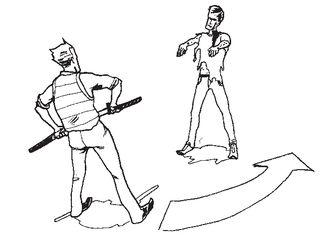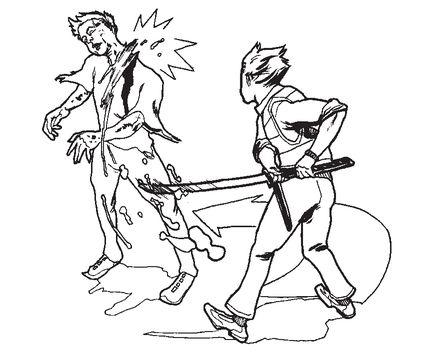The Zombie Combat Manual (28 page)
Read The Zombie Combat Manual Online
Authors: Roger Ma

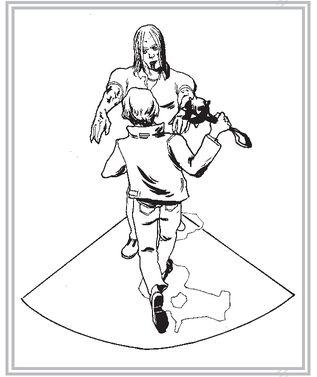
Unfortunately, many individuals mistakenly engage an attacking ghoul this way, as it is how we universally confront human adversaries. Never forget that your opponent is now anything but human. You must contend with not only a zombie’s gnashing mouth, but also its scratching, infected hands, which at this point will be outstretched and seeking to pull you toward its open jaws. The triangular area comprising the ghoul’s mouth and two hands is what’s known as the fatal funnel. Your strategy in this situation should be to take advantage of the zombie’s restricted speed and coordination and work the perimeter of your opponent for your attack.
Dismembering the Undead
When employing an edged weapon in melee combat, you may experience the urge to begin hacking away randomly at your attacker, turning it into a pile of chopped zombie detritus. This tactic seems to be taken advantage of most often by individuals who suffer from PUCT or have recently experienced intense emotional distress from a zombie attack, such as the loss of a friend or loved one. Resist this inclination, as it is not encouraged for several reasons:
1.
The undead feel no pain:
Although you may believe that you are delivering some form of “human justice” by slicing your opponent into ribbons, hacking off the arm of a zombie does no more to injure or inflict pain than tapping it on the shoulder. Your opponent will remain unfazed and continue its attack. Save your energy for a single, finishing strike.
2.
You amplify the risk of infection:
You may contend that severing a zombie’s hands eliminates its ability to grab you. This is true. By cutting off its hands, however, you have only eliminated its means of grabbing you, not its desire to do so. Instead of two groping hands where the infection is somewhat contained, you will have two infected, gelatinous stumps reaching for you, leaking contagious fluid. Remember that the second-highest cause of infection results from contact with existing wounds on a walking corpse. Any laceration you inflict that does not result in threat neutralization causes an open sore packed with infectious tissue, making the ghoul a more hazardous opponent.
3.
It is overkill:
Just as smiting the top of a zombie head with overwhelming force may be overkill, so is excessive hacking at melee range. Using an edged weapon in undead combat requires that you keep your blade sharpened and ready at all times. By using your weapon to dismember rather than eliminate a target, you not only waste precious time, strength, and energy, you create more work for yourself once the engagement has ended by needing to rehone your blade’s edges. Your objective in any zombie combat situation is to end it as quickly as possible, not to prolong your encounter out of rage or personal satisfaction. Any strike that does not contribute to stopping an attacking ghoul is an unnecessary one.
Combat Techniques
Many of the strategies detailed in long-distance combat such as the Musashi and the Blindside can also be used in melee-range encounters. Some specific techniques particular to this distance can also prove very useful for fighting the undead while at the same time avoiding the fatal funnel.
STRACIRS TECHNIQUE
TARGET AREA: TEMPORAL, NASAL/ORBITAL, OR OCCIPITAL REGIONS
MOST EFFECTIVE WITH: BLUDGEONS (MACES, HAMMERS, CLUBS)
Technique:
One of the simplest techniques to employ at melee range to neutralize your attacker while steering clear of the fatal funnel is the StraCirs (pronounced “STRAY-cers”) technique. This technique is composed of three movements that will keep you clear of the zombie’s primary threat zones while creating options for your own attack. As you enter melee range, a zombie will most likely have its arms extended, hands grasping for you, attempting to grab your body—at which time, you will begin the first movement:
1.
Strafe:
Your initial move should be to side step, or “strafe” left or right of your attacker. This word in this context originates from the first-person shooter (FPS) video game genre, meaning to shuffle side-to-side while keeping your torso constantly facing the same direction. The intention is to move out of reach of the zombie’s grasp while not losing sight of your opponent. Do not turn away from your attacker during this movement. At melee range, zombies have been known to lurch suddenly in an attempt to grab their victim.
2.
Circle:
Once you have strafed to either side, begin moving in a circular pattern around your opponent, ending at the left or right side of your attacker; you could continue circling until you end up directly behind it, but this obviously requires more time. By moving in a circular pattern, you are taking advantage of the zombie’s lack of coordination. A normal human attacker would most likely pivot at the same speed and in the same direction should you attempt to outflank him. Using the ghoul’s lack of speed against it, you are able to remain out of reach while exposing several prime anatomical targets for your assault.
3.
Strike:
Once you have circled your opponent and find yourself in an advantageous position, you have several target options. Depending on where you complete the movement, the occipital region, the temporal region, and the nasal/ orbital region are all available targets. Remember, the zombie does not possess the intellect to block an oncoming blow, so choose whichever target suits your weapon best. Strike quickly and decisively.
As you become proficient in this technique, you will be able to combine the first two movements into one smooth transition, known also in gaming terms as the
circlestrafe.
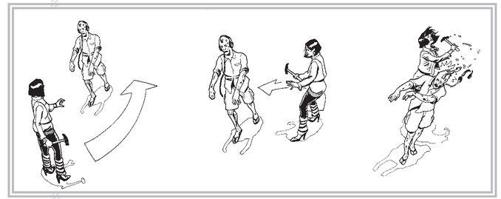
As we covered in the discussion of weapons, you will employ one of two kinds of armaments at melee range—either a blunt instrument or an edged weapon. Bladed arms, such as a sword or machete, tend to be less effective at direct strikes to the zombie cranium. Blades have a tendency to either glance off the skull or embed themselves deeply in the head of a zombie after your blow. Striking the hard cranial bones can quickly dull your fine cutting edge. With an edged weapon, a more efficient strategy is to decapitate your opponent.
As the act of fully decapitating an opponent is much more difficult than most people realize, we have developed a technique similar to the StraCirs maneuver, but specifically designed for edged weapons.
THE LUMBERJACK
TARGET AREA: NECK AND THROAT REGION
MOST EFFECTIVE WITH: BLADED IMPLEMENTS (SWORDS, MACHETES, AXES)
Technique:
Watch any woodsman’s technique as he is in the process of felling a tree, and you will note that he does not hack away at an identical spot on the trunk over and over. Rather, he approaches his target from several angles, “notching” the log before splitting it all the way through, thus minimizing the likelihood of his tool becoming wedged and speeding up the entire process dramatically. You can use a similar approach with an edged weapon against the neck of the undead:
1.
Circlestrafe:
Just as in the previous blunt-trauma-weapon maneuver, your first step should be to shift out of the ghoul’s fatal funnel.
2.
Strike:
Chop the neck with your blade, making sure you use an ample amount of force to inflict a deep, severe laceration.
